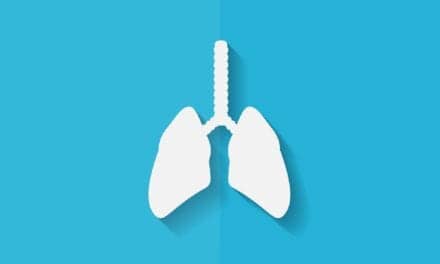Up to 70 percent of COPD Patients may be significantly malnourished.
Malnutrition is surprisingly common, and the clinical appearance of chronic obstructive pulmonary disease (COPD) patients often belies the fact that they are significantly malnourished. Uncovering this fact has clinical significance; over the past few years, there has been an increase in research into and understanding of the clinical prevalence and adverse effects of malnutrition and possible therapeutic maneuvers available to reverse this clinical state. Malnutrition may be present in 25 percent to 70 percent of COPD patients, with the largest percentage found among patients with emphysema1,2 and chronic hypoxemia.3 Weight loss is an independent prognostic factor for a poor survival rate,4 even in groups of patients having values for forced expiratory volume in 1 second (FEV1) that are more than 40 percent of the predicted value.5 In patients stratified for FEV1, there is a correlation between body weight and mortality, making nutritional assessment an important tool in prognostic stratification.4,6
Malnutrition in COPD
Nutritional status affects many aspects of ventilatory function in patients with COPD. Malnutrition may adversely affect respiratory muscle function, resulting in decreased exercise performance,7 reduced ventilatory drive,3 reduced ventilatory capacity, and diminished respiratory muscle strength.3,8 Muscle catabolism occurs when the patient is in a hypermetabolic state, whether acute or chronic. This muscle catabolism includes the diaphragm and intercostal muscles.3,9,10
In addition to the catabolic state, COPD patients have a negative feedback association with activity because of the respiratory discomfort they experience during exercise; they may, in response, reduce their daily activities. This starts a vicious cycle in which reduced exercise results in disuse muscle atrophy, and even further deconditioning promotes dyspnea and the desire to curtail daily activities further.11
COPD patients are characterized by a number of adverse metabolic adaptations that affect the aerobic capacity of exercising muscles unfavorably. These include a chronic reduction in oxygen supply, decreased cardiovascular adaptation, an elevated oxygen cost of ventilation (and, hence, a stealing of blood flow from peripheral muscles), and biochemical alterations in the oxidative capacity of peripheral muscles.11
In addition to its effects on muscle function, malnutrition affects cell- mediated (T-cell) immunity through reduced intracellular killing and decreased lymphocyte numbers.3,10 There also seems to be increased bacterial colonization of subglottic tracheobronchial epithelial cells and, hence, increased incidence rates for gram-negative pneumonias.9
There are many presumed mechanisms for the development of malnutrition in patients with COPD.5 Hypermetabolism is defined as an increase in energy expenditure of 10 percent above the expected resting energy expenditure (REE). It appears that up to 40 percent of patients with COPD have REE levels that are 10 percent to 20 percent above their predicted values. COPD patients are unable to become adaptively hypometabolic while losing weight (unlike patients with other diseases that cause weight loss). Reduced mechanical efficiency also seems to increase the oxygen cost of breathing and contribute to the increased REE associated with the loss of lean weight over time.11,12 The muscles of COPD patients have an elevated demand for oxygen. There may be a deficient oxygen supply that is, a lower cardiac index than would be expected, compared to normal patients with a similar oxygen debt. The constant lack of sufficient oxygen, an energy precursor, may be a cause for the loss of tissue mass.13 This is emphasized in times of increased demand, such as exercise, when respiratory muscles may demand more oxygen and steal the (limited) cardiac output from the peripheral muscles. Other potential causes for hypermetabolism include the cytokine milieu5 and the use of b2-agonists or theophylline.2
Acute weight loss may occur during an acute COPD exacerbation. This may be due to a confluence of causes known to affect nitrogen balance adversely during the acute episode. These include inflammation (hence, cytokine activation), steroid use, increased metabolic needs of the respiratory muscles, inactivity, and, more often than not, decreased caloric intake.13 Weight is usually regained after recovery. The common weight loss seen in COPD is chronic and develops over time. A reduction in intake would naturally tip the balance of nutritional homeostasis in the favor of weight loss. Dietary histories are unreliable in assessing the caloric intake of patients and may be deceivingly reassuring. Various reasons have been postulated as causes for reduced intake in COPD patients, including arterial oxygen desaturation during eating (secondary to the breathing-pattern changes of swallowing and chewing), gastric filling that reduces the functional residual capacity and leads to increased dyspnea,5 and the anorexiant effect of medications. Other possible causes are symptoms such as bloating and early satiety. Meal desaturation occurs mainly in patients who are hypoxemic at rest. The use of steroids is common in COPD patients. High-dose corticosteroid therapy is known to affect muscle function adversely in COPD patients, but lower doses, while known to promote complications such as osteoporosis, have not been conclusively shown to result in a malnourished state.2,13
Diagnosis
It is clear that not all COPD patients are equal. Certain outcome predictions may be made using nutritional measurements. For example, patients with a percentage of ideal body weight of less than 90 percent (using standards from the Metropolitan Life Insurance tables) have an increased mortality rate over a 5-year period. Patients with a reduced fat-free mass, as determined by either bioelectric impedance or direct measures of muscle mass, have reduced exercise capacity. How does one formally assess a patient’s clinical nutritional state? There are many answers to this question, but the best approach depends on the clinical situation and the availability of resources. Body weight, as a percentage of ideal weight, is readily determined by weighing the patient, but this does not differentiate between the two theoretical components of total body weight (fat mass and fat-free mass). Using body weight as the sole measure of nutritional status may lead to an underestimation of malnutrition in COPD patients.14
One can assess fat-free mass using bioelectrical impedance; such an assessment may, however, fall into the realm of rehabilitation experts. Bioelectrical impedance measures the resistance to an imperceptible current (conducted by the body’s water and electrolytes) between a unilateral hand and foot. Because the body’s water and electrolytes are concentrated in the fat-free mass, a mathematical relationship exists between the height of the person, resistance to current flow, and the size of the lean body mass.13
Nutritional assessment may also be achieved by using anthropometric measurements such as triceps skin-fold fat stores (thickness) and midarm muscle circumference. These measurements can then be applied to mathematical formulae that predict fat and fat-free mass based on the values of previously measured normal volunteers. Both bioelectrical impedance and anthropometric measurement require technical expertise, making them impractical for the general outpatient setting. They can, however, be readily incorporated into any pulmonary rehabilitation program to provide a more comprehensive assessment of potential limitations and objective progress in the patient with COPD. Visceral protein stores are assessed using blood parameters such as albumin, prealbumin, or transferrin. Many of these parameters, though, are reduced in the face of aging, steroids, and chronic infection, so their usefulness as a nutritional assessment tool may be lessened.13
A functional assessment of nutritional status would evaluate muscle power and fatigability. These functions could be affected by a reduction in muscle mass secondary to protein catabolism or by the depletion of necessary intracellular electrolytes. Standardized tests involve measuring the strength of contraction created by the electrical stimulation of a muscle. Although these tests are preferred because they eliminate the component of patient motivation from testing, they generally require specialized skills and equipment. Testing of maximal voluntary contraction of muscles (handgrip dynamometry or respiratory muscle pressures) is a standard procedure for most pulmonary function laboratories. Of these methods, handgrip-strength testing can be incorporated into an initial assessment with little difficulty and can be used serially to confirm strength changes stimulated by nutrition and exercise.13
An ongoing loss of weight should be a trigger for further evaluation and intervention. Patients with an initially low weight also require further attention. Of course, it goes without saying that a careful (corroborated) weight history would provide important clues to the patient’s recent nutritional status. Referral to a dietitian in completing this evaluation, and for help in intervening, is invaluable. One’s index of suspicion should be heightened in a patient with a consistent reduction in body weight, as measured at regular screening opportunities. Progressive weight loss predicts impaired exercise function, and weight loss below 90 percent of ideal body weight particularly predicts increased mortality.4
Functional assessments of muscle strength (using handgrip dynamometry) and immune function may be employed to assess baseline levels and responses to nutritional and other interventions.13 These interventions would be individualized based on an individual patient’s circumstances and needs.
NUTRITIONAL INTERVENTIONS
Supplemental oral nutrition can result in a significant increase in both respiratory and limb-muscle strength, as well as improved muscle contractility and improved endurance.2 This may be secondary to improving intracellular electrolytes.3
There are also improvements in subjective scores of breathlessness as well as exercise ability. Respiratory muscle function percent improvement seems to depend on increased weight after at least short-term nutritional therapy. Weight gain may mistakenly be interpreted as favorable, yet may be predominantly in fat mass, which does not augur as well as a gain in fat-free mass.2
Achieving weight gain using a simple outpatient nutritional program is difficult. Programs are usually intensive and expensive.15 Even patients admitted to inpatient units are unable to maintain nutritional support once discharged.16 Patients often reduce their own food intake while receiving supplemental feedings, instead of boosting their caloric intake.15 Unfortunately, in general, the results of nutritional intervention in stable COPD patients have been disappointing. Although it has been shown that effective intervention resulting in weight gain does improve respiratory function, it seems very difficult to achieve this endpoint practically.5,12,13
How do we estimate and measure nutritional requirements? Practical estimates of caloric needs in patients with pulmonary diseases can be made using the Harris-Benedict equation, which relates energy expenditure to gender, weight, height, and age. It assumes standard body composition, though, and does not take into account the alteration in fat-free mass that occurs in these patients. The most accurate method available is direct measurement using a metabolic cart. This is often impractical, however, and there often is a margin of error introduced by the variability of stressors over the time of measurement. With indirect calorimetry, oxygen and carbon dioxide volumes can be measured by having the patient wear a nose clip and breathe through a mouthpiece. Room air is inhaled; exhaled air is channeled into a mixing chamber for analysis. A neck tent or canopy may also be placed on the person’s head (with a neck seal). In mechanically ventilated patients, exhaled air may be piped directly to the calorimeter. To monitor the adequacy of protein intake, nitrogen balance can be estimated using standard methods.
Treatment
Isolated nutritional support has limited efficacy. Physical activity is important in muscle protein synthesis.13 The use of exercise (a pulmonary rehabilitation program) with nutritional intervention may improve lean tissue mass and, thus, respiratory function.18 When oral nutritional supplements are given, they should be given at the end of meals or between meals so that the usual calories will still be consumed. The most reliable method of assessing food consumption is recording portion weights. Self- reporting of diet is notoriously inaccurate.10
It has been proposed that the use of meals high in carbohydrates may promote carbon dioxide production and adversely load the ventilatory system.18 Although this applies to mechanically ventilated patients,12,19,20 it may not be true of stable COPD patients. In all patients with respiratory disease, the problem with dietary composition is more significantly related to the provision of too many calories, rather than the diet’s composition. Exercise capacity may be slightly reduced following a large carbohydrate meal,21 although the clinical significance of this is questionable. Special supplements high in fat do not seem to be necessary for nutritional support in patients with stable COPD.9,10,22
Calories supplied at 1.3 times the measured or estimated REE will meet ongoing energy requirements and limit further weight loss in most cases. This proportion can be titrated upward to prevent weight loss in patients who continue to lose weight. Protein needs are 1 to 2 g/kg a day, corresponding to about 20 percent of total energy taken in. It is important to limit the adverse effects of infections, disuse, steroids (as much as possible), and hypoxemia on skeletal muscle function. These factors, for reasons previously mentioned, help promote ongoing muscle wasting. In conditions involving major stessors, the energy requirements will increase.11 To design an appropriate meal plan for the patient with COPD, one should enlist the help of a dietitian and be prepared to deal with often-reported complaints (such as bloating, anorexia, and dyspnea) that may develop as the patient attempts to increase intake.19
It is important to remember to make the food palatable, presentable, and affordable in order to maximize compliance. Other important areas to cover are the nutritional adequacy of meals, the availability of the correct foods in sufficient quantities, and the use of nutritional supplements (bearing in mind that reliance on nutritional supplements may be counterproductive if they are used as meal replacements rather than supplements). There is ongoing research into novel approaches to produce improvements in lean body mass for example, using growth hormone. Studies thus far have been conflicting and, unfortunately, discouraging.22
Conclusion
One should have a high index of suspicion for malnutrition in COPD patients. There are simple techniques, however, that will help in patient assessment. Enlisting the help of a dietitian and providing the opportunity for a combined approach to therapy involving rehabilitation, support, and nutritional intervention is the most effective approach to treating these patients.
Paul Zolty, MD, is a pulmonary and critical care fellow at the University of Pittsburgh Medical Center, in Pennsylvania.
Acknowledgments
Grateful thanks to Michael Donahoe, MD, for providing guidance and editing and reviewing the manuscript, and librarian Rosa Raskin, for indispensable assistance.
References
- Wilson DO, Rogers RM, Hoffman RM. Nutrition and chronic lung disease. Am Rev Respir Dis. 1985;132:1347-1365.
- Engelen MPK. Nutritional depletion in relation to respiratory and peripheral skeletal muscle function in out-patients with COPD. Eur Respir J. 1994;7:1793-1797.
- Pingleton SK. Enteral nutrition in patients with respiratory disease. Eur Respir J. 1996;9:364-370.
- Wilson D, Rogers RM, Wright EC, Anthonisen NR. Body weight in COPD. The National Institute of Health Intermittent Positive Pressure Breathing Trial. Am Rev Respir Dis. 1989;139:1435-1438.
- Muers MF, Green JH. Weight loss in chronic obstructive pulmonary disease. Eur Respir J. 1993;6:729-734.
- Palange P. Letter. Chest. 1996;109:586.
- Gray-Donald K. Effect of nutritional status on exercise performance in patients with chronic obstructive pulmonary disease. Am J Respir Crit Care Med 1989;140:1544-1548.
- Efthimiou J, Fleming J, Gomes C, Spiro SG. The effect of supplementary oral nutrition in poorly nourished patients with chronic obstructive pulmonary disease. Am Rev Respir Dis. 1988;137:1075-1082.
- Mowaatt LC, Brown RO. Specialized nutritional support in respiratory disease. Clinical Pharmacy. 1993;12:276-292.
- Thomsen C. Nutritional support in advanced pulmonary disease. Respir Med. 1997;91:249-254.
- Palange P, Forte S, Felli A, Galassetti P, Serra P, Carlone S. Nutritional state and exercise tolerance in patients with COPD. Chest. 1995;107:1206-1212.
- Schols AMWJ. Nutrition and outcome in chronic respiratory disease. Nutrition. 1997;13:161-163.
- Donahoe M. Nutritional support in advanced lung disease. The pulmonary cachexia syndrome. Clin Chest Med. 1997;18:547-561.
- Laaban JP, Kouchakji B, Dore MF, Orvoen FE, David P, Rochemaure J. Nutritional status of patients with chronic obstructive pulmonary disease and respiratory failure. Chest. 1993;103:1362-1368.
- Sridhar MK. An out patient nutritional supplementation programme in COPD patients. Eur Respir J. 1994;7:720-724.
- Rogers R, Donahoe M, Costantino J. Physiologic effects of oral supplemental feeding in malnourished patients with chronic obstructive pulmonary disease: a randomized control study. Am Rev Respir Dis. 1992;146:1511-1517.
- Schols AMWJ, Slangen J, Volovics A, Wouters EFM. Body weight and survival in COPD. Am J Respir Crit Care Med. 1996;153:A452.
- Vito A, Angelillo A, Bedi S, Durfee D, Dahl J, Patterson AJ, O’Donohue WJ. Effects of low and high carbohydrate feedings in ambulatory patients with chronic obstructive pulmonary disease and chronic hypercapnia. Ann Intern Med. 1985;103:883-885.
- Fitting JW. Nutritional support in chronic obstructive pulmonary disease. Thorax. 1992;47;143.
- Brown SE, Nagendran RC, McHugh JW, Stansbury DW, Fischer CE, Light R. Effects of a large carbohydrate load on walking performance in chronic airflow obstruction. Am Rev Respir Dis. 1985;132; 960-962.
- Efthimiou J, Mounsey PJ, Benson DN, Madgwick R, Coles SJ, Benson MK. Effect of carbohydrate rich versus fat rich loads on gas exchange and walking performance in patients with chronic obstructive lung disease. Thorax. 1992;47:451-456.
- Burdet L, de Muralt B, Schutz Y, Pichard C, Fitting JW. Administration of growth hormone to underweight patients with chronic obstructive pulmonary disease: a prospective, randomized, controlled study. Am J Respir Crit Care Med. 1997;156:1800-1806.
- Grant JP. Nutrition care of patients with acute and chronic respiratory failure. Nutrition in Clinical Practice. 1994;9:11-17.









